
|
![]()
Greatest Films of the 1930s
1930 | 1931 | 1932 | 1933 | 1934 | 1935 | 1936 | 1937 | 1938 | 1939
Title Screen Film Genre(s), Title, Year, (Country), Length, Director, Description 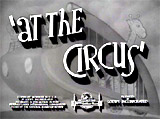
At The Circus (1939), 87 minutes, D: Edward Buzzell
MGM's satirical slapstick comedy film was the 9th film featuring the Marx Brothers, a second-rate, mad-cap effort that recycled familiar gags amongst its stars: Groucho as disreputable, double-talking shyster attorney J. Cheever Loophole (nicknamed "The Legal Eagle"), his nemesis and frequent co-star Margaret Dumont as Mrs. Dukesbury, and Chico and Harpo as circus members: con-artist Antonio "Tony" Pirelli and carnie "Punchy," and various musical numbers on the piano and harp. In the mostly insignificant plot, 3-ring circus manager and owner Jeff Wilson (Kenny Baker) of Wilson's Wonder Circus was romantically paired with his girlfriend Julie Randall (Florence Rice), who performed on horseback under the bigtop. Due to Wilson's mortgage indebtedness and the possibility of foreclosure, he had hidden circus funds of $10,000 in the circus train's cage of a gorilla named Gibraltar. Wilson's unscrupulous business manager and creditor-partner John Carter (James Burke) was threatening to buy out the circus, and had two accomplices working for him in the circus: strongman Goliath (Nat Pendleton) and midget Little Professor Atom (Jerry Marenghi). The unsuspecting Jeff's $10,000 dollars were stolen when he was knocked out by Carter's men. Tony and Punchy summoned NY lawyer Loophole to investigate the situation, to try to link evidence left at the scene (a cigar) with the crooks. He also failed to obtain the stolen funds hidden in the bodice of Carter's moll girlfriend and aerialist Peerless Pauline (Eve Arden), a human fly. At last, Loophole conned hefty Newport widowed socialite Mrs. Susanna Dukesbury (Margaret Dumont), Jeff's wealthy dowager aunt, into paying the circus $10,000 to perform at her mansion's private and fancy society party for 400 guests. He was able to foil and change the original plans of pompous French conductor Jardinet (Fritz Feld) and his Paris symphony orchestra to perform (they were set adrift on a floating bandstand). The film concluded with the escape of the gorilla, Carter's attempt to set the circus on fire, wild escapades on the flying trapeze (including Mrs. Dukesbury being shot out of a cannon), and Gibraltar's retrieval of the stolen money. Highlights in the film included Groucho's song "Lydia the Tattooed Lady" and his insulting repartee with Dumont, the badges skit, Punchy's leopard costume and ride atop an ostrich, the bedroom-evidence scene to 'redestruct' the crime, and the big top chase finale.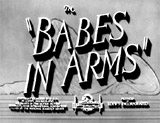

Babes in Arms (1939), 93 minutes, D: Busby Berkeley
Famed surrealist choreographer Busby Berkeley's directorial effort was the first pairing of stars Judy Garland and Mickey Rooney in a "let's put on a show musical," the third film they were in together, and MGM's biggest hit of the year (even greater than The Wizard of Oz (1939)!). It was also the legendary Arthur Freed's first movie as a producer for MGM. The film featured lots of singing, dancing, and comedy impersonations (Rooney mimicked both Clark Gable and Lionel Barrymore). It included the title song "Babes in Arms," and "Good Morning," "God's Country," "Broadway Rhythm," "I Cried For You," "The Lady is a Tramp," and "You Are My Lucky Star." Two talented yet struggling young artists (singers and musicians) in their town of Seaport, Long Island, Mickey Moran (Mickey Rooney) and pretty singer/girlfriend Patsy Barton (Judy Garland), both children of ex-vaudevillians, teamed up to put on a grand show. They wished to raise money for their ailing parents in hard-times who wanted to revive their entertainment careers and not lose their homes. The two were opposed by the busybody head of the welfare board Martha Steele (Margaret Hamilton), who believed the youngsters should be in a "work" school instead, and by ex-child movie star Rosalie Essex (known as Baby Rosalie) (June Preisser) who competed with them for her own comeback. She proposed to financially support Mickey's musical project, but only if she took Patsy's lead role (as performer and girlfriend!).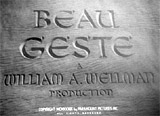


Beau Geste (1939), 114 minutes, D: William A. Wellman
Director Wellman's and Paramount's oft-made, stirring melodramatic adventure tale was the best of three screen versions, although it was a remake (there was also a silent version in 1926 and a third film in 1966). There was also a humorous take-off of the film called The Last Remake of Beau Geste (1977). The story, adapted by Robert Carson, was based on P.C. Wren's 1924 novel - a tale that emphasized loyalty and brotherly love. The film began with the perplexing yet unforgettable opening sequence of a French Foreign Legion relief patrol on the Saharan desert sand dunes coming upon a seemingly-deserted and completely silent Fort Zinderneuf. In command, Major Henri de Beaujolais (James Stephenson) rode closer and discovered dead Legionnaire soldiers propped up against the parapets, lending an air of mystery and drama to the story. One of the three brothers Geste, bugler Digby Geste (Robert Preston) was chosen to climb the wall and investigate the unusual scene, but failed to return to his company. Upon entering the fort, the dead commanding Sergeant (with a French bayonet in his chest) was found with a hand-written confession admitting the theft of a precious family gem: "...and I hereby confess that it was I who stole the great sapphire known as the "Blue Water" from Brandon Abbas." There was also the body of a young legionnaire next to him, but then both bodies disappeared. Then shortly later, the fort was destroyed in flames. [Note: In explanation, the dead body of legionnaire Michael "Beau" Geste (brother of Digby) was lying nearby the body of commanding legionnaire Sgt. Markoff (Brian Donlevy), who was pierced with a French (rather than Arab) bayonet. It was Beau's confession that was found in the Sgt.'s hand.] The film then flashbacked to fifteen years earlier to introduce the three Geste brothers: Michael "Beau" Geste (Gary Cooper as adult, Donald O'Connor as child), John (Ray Milland as adult, Billy Cook as child), and Digby (Martin Spellman as child). The boys lived at Brandon Manor in England, as wards of their impoverished Aunt, Lady Patricia Brandon (Heather Thatcher). After growing up, the brothers all joined and served in the Foreign Legion together, and had to persevere against Arab attacks and their tyrannical officer Sgt. Markoff. The events at the fort were eventually sorted out. (1) Beau had died in the fort at the hands of the vicious Sgt. Markoff, but then John Geste was able to bayonet Markoff in the heart with his sabre - in revenge. John held his lethally-wounded brother Beau in his arms, and was handed a note publically confessing that he had stolen the Brandon family's "Blue Water" sapphire. John was also given a private letter written for Lady Brandon; then, John escaped from the fort, (2) after Digby entered the fort, he fulfilled and honored his heroic brother Beau's childhood request for a fiery "Viking's funeral," and also set the fort on fire in the process. Digby escaped off the back wall, but was later shot dead by an Arab sniper. The story, in flashback, centered around the financial difficulties of the Brandons, who were left with the choice of selling the family's rare gem known as the "Blue Water" sapphire. [Another twist was added: "Beau" was the only one who knew that the family's real "Blue Water" sapphire had been sold many years earlier to an Indian buyer by Lady Brandon, and replaced with a worthless fake jewel.] "Beau" confessed to the theft of the "Blue Water" sapphire (the fake) to save the honor of Lady Brandon - a dramatic scene during a viewing of the gem when the lights went out and he disappeared. The three boys eventually joined up together in the Foreign Legion, and fought long enough to save and clear the family name. In the film's concluding scene, John Geste, the only surviving Geste son, presented Lady Brandon with the private letter from his deceased brother Beau, disclosing that her prized valuable gem - "The Blue Water" sapphire, had been sold years before and that Beau had stolen a substitute gem to save her the embarrassment of selling it - she read the letter aloud at the foot of the stairs: ("Dear Pat: I was inside the suit of armor in the hall the day you sold the Blue Water to the Maharajah's agent and received an imitation to take its place. When the wire from Sir Hector came, I thought I could repay your devotion to us by giving Brandon Abbas its first robbery. So the lights went out and so did Beau. Lovingly, Beau Geste"). After learning that her devoted "Beau" had acted gallantly years earlier, by sparing her humiliation over the jewel's sale, she spoke the film's final line: "Beau Geste? Gallant gesture. We didn't name him wrongly, did we?"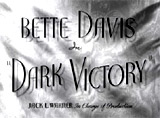


Dark Victory (1939), 105 minutes, D: Edmund Goulding
Director Edmund Goulding's melodramatic tearjerker featured Bette Davis in one of her most powerful and memorable roles. It was one of four films that Davis made in 1939, including The Old Maid, Juarez, and The Private Lives of Elizabeth and Essex. The film was remade as Stolen Hours (1963) (aka Summer Flight), starring Susan Hayward. In the story, high-living, flighty Long Island socialite/heiress Judith Traherne (Bette Davis) lived a carefree hedonistic life (with horse-riding), along with playboy Alec Hamin (Ronald Reagan). When her eyesight was starting to dim, she was diagnosed as having a brain tumor ("prognosis negative"). After a seemingly successful operation by her neuro-surgeon, Dr. Frederick Steele (George Brent), she fell in love with her doctor and found happiness, only to discover that she actually had only one more year to live. First resorting to more meaningless parties, rejection of the doctor, and despair, she then found true meaning and happiness in her life. She added great substance to her final days in Vermont and died with resigned dignity (in a climactic stair-climbing scene with Max Steiner's swelling score), with the support of her best friend and loyal secretary Ann King (Geraldine Fitzgerald).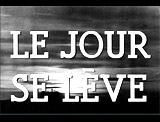




Daybreak (1939, Fr.) (aka Le Jour Se Lève), 88 minutes, D: Marcel Carné
This was one of the great works of 1930s poetic realist cinema - functioning as a psychological, noirish melodrama. The film was banned by the Vichy government in France after its theatrical release, for its dark and demoralizing pessimism and political commentary. It was remade by RKO as director Anatole Litvak's The Long Night (1947) with Henry Fonda. François (Jean Gabin), a hard-working French factory worker as a sandblaster, angrily gunned down and murdered sinister, cruel, manipulative, and dishonest womanizing cad M. Valentin (Jules Berry), a vaudeville nightclub dog trainer. He desperately locked himself in his furnished, one-room attic apartment (surrounded by police awaiting daybreak) at the top of a six-story building. Through a series of dissolves as he awaited dawn, he experienced three flashbacks to recall and reflect upon why he was led to murder, while chain-smoking and awaiting his fate. He had met young florist shopgirl Françoise (Jacqueline Laurent), an orphan like himself, and they fell in love. But at the same time, François was strongly attracted to Valentin's mistreated, yet attractive and sexually provocative assistant Clara (Arletty), and Françoise was under the spell of Valentin. A deadly love quadrangle of sorts developed between the characters, leading to François' jealous rage against the Machiavellian Valentin. One of Valentin's false claims was that Françoise was his long-lost daughter. In the end, the despairing François took his own life, as the police's tear gas filled his apartment.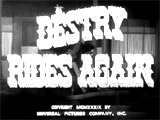

Destry Rides Again (1939), 94 minutes, D: George Marshall
Director George Marshall's popular and marvelous Western comedy spoof/farce from Universal Pictures was a satirical parody of the classic Western with its stereotypical elements - a lawless Western town with a saloon and a sheriff and three saloon/musical numbers! The western was set in the Last Chance Saloon in the wild Western town of Bottleneck. The town's bar-room was corrupt and out of control, run by unscrupulous saloon owner Kent (Brian Donlevy), who featured in his wild saloon the lusty, sexy dance-hall singer Frenchy (Marlene Dietrich, reprising her sexy role from The Blue Angel (1930)). It was memorable for Frenchy's rendition of "See What the Boys in the Back Room Will Have" and for the roughest female catfight - a bar-room brawl - in film history (a marathon wrestling match pitting Frenchy against Mrs. Callahan (Una Merkel)). The son of a famous brave lawman, laconic, peace-loving Tom Destry (James Stewart) was summoned to the town to tame it - but he was a milk-drinking, soft-spoken, mild-mannered, gunless sheriff. Despite his shortcomings, Destry was able to keep the peace, in between his attempts to resist the charms of Frenchy. Destry shot Kent, but heroine Frenchy collapsed and died in his arms, mortally wounded in the back from Kent's bullet. Before dying, she let him know that she loved him, gasping: "Would you kiss me goodbye?"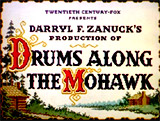



Drums Along the Mohawk (1939), 103 minutes, D: John Ford
Director John Ford's action-adventure epic-historical drama was his sole film set in colonial America, during the pre-Revolutionary War era. It highlighted the harshness of survival and savage Indian attacks in the Mohawk Valley wilderness of upstate colonial New York. In the opening scene set in July of 1776, Lana "Magdelana" Borst (Claudette Colbert), a young, frightened, cultured and well-bred bride from the Eastern city of Albany, NY, was wed to her loving husband Gilbert "Gil" Martin (Henry Fonda) in her home. On their honeymoon, they immediately traveled to a cabin built by Gil in central/upstate NY's Mohawk Valley, in the town of Deerfield, to join other settlers on the frontier. Unfortunately the area was being plagued by Indian attacks. On the way, they spoke to a menacing, eye-patched local Tory named Caldwell (John Carradine), who was allied with a force of Mohawk Indians. During her first night in her new home, Lana was startled and shocked by the appearance of friendly Indian brave Blue Back (Chief John Big Tree), a Christian convert; when she became crazed and hysterical and cried out: "He'll murder us!", Gil had to slap her to restore her to her senses: ("You've gotta get a hold of yourself"); Lana expressed upset with the primitive conditions and threatened to return home: "I can't stand it! Mother was right. I'm no frontier woman. I had no idea it was like this"; Gil affirmed: "You're gonna stay right here and do as I say from now on. You're gonna get over this foolishness and stop being scared" - and then he apologized; Blue Back recommended that Gil keep a switch above the fireplace - handy if he needed to further keep her in line: ("Lick her good! Make fine woman"). At first, the harsh life proved to be a difficult adjustment for Lana. At the fort in the nearby settlement of German Flats, the Martins met other local residents; the locals had formed a militia to be trained to protect themselves. Gilbert was enlisted in the community militia under General Herkimer (Roger Imhof) at a time when the struggle for independence from England was turning into "a real war." Later as the Martins cleared their farm land with other settlers, warnings came from Blue Back that a native war-party of marauding Seneca Indians, led by Caldwell, were on the "warpath" and threatening to attack. To seek refuge as the Indians burned their cabin and haystacks, they fled to the nearby fort. The pregnant Lana was taken frantically to the fort in a large wagon, where she fainted and miscarried her first child. With their home and crops destroyed, Gil and Lana commiserated with each other when they returned and surveyed the ruins: (Gil: "It doesn't seem possible people can work as hard as we did, Lana - for nothin'" Lana: "We can build it back again, Gil"). Gil spoke about how he shouldn't have let her come in the first place: "This is no place for you. It's no place for any woman." With the cold winter approaching, the Martins were fortunate to be hired by feisty elderly widow and stubborn frontier matriarch Sarah McKlennar (Edna May Oliver). Her hired man had just drunkenly run off. They replaced him as paid live-in servants and farm workers at her home, to make a new start in life. She bluntly told them: "I've got a long face and I poke it where I please." It was soon announced during a Sunday service by the community's stern Reverend Rosenkrantz (Arthur Shields) that another attack of Torys (British soldiers) and "savage" Indians was imminent, so Gilbert was pressured to report the following morning for duty to General Herkimer. Standing on a hilltop during an impressively-filmed sequence, Lana watched as a column of troops (with her husband among them), marched off into the distance to be readied for battle, to the tune of "Yankee Doodle" played on fife and drum. She collapsed onto the ground as the sequence ended. Gilbert and the local group of militia defended against the attack, but were ambushed and many men perished. General Herkimer suffered a serious leg injury and later died of blood loss during a botched amputation operation. Gilbert was wounded - he returned home delirious, but was able to deliver a step-by-step, detailed account of the Battle of Oriskany (in August of 1777) to Lana. He ended his account with joy over their victory: "Out of 600 of us, about 240 were still alive, but we'd won. We licked 'em....We showed 'em they couldn't take this valley." Now pregnant a second time, Lana was overjoyed when she gave birth to a son during a long period of peace. However, the Indians regrouped and made another major attack. Elderly widow Sarah refused to leave her bed in her home during the assault and seek shelter in the fort. She reprimanded two Indian warriors: "What do you mean coming in my house?" She persuaded them to carry her, in her bed, out of her bedroom before setting it ablaze ("I won't move a step without my bed...Stop that! Shame on you. Get this bed out of here quick...I'm not leaving this house. I've lived in it all my life"). As her house burned down around her, Gil had to forcibly pick her up and evacuate her. The settlers were again forced to seek refuge in nearby Fort Herkimer at German Flats where the women valiantly fought side-by-side with the men. One of the casualties of the skirmish was Mrs. McKlennar. As she died (from a fatal arrow wound in the chest), she bequeathed her farm and some gold pieces to the Martins: ("I want you and Gil to have my place - everything. You've been like my own flesh and blood"). In the stirring finale during the siege of the fort, ammunition supplies ran out, and Gil offered to go for regular army reinforcements. He took the place of Joe Boleo (Francis Ford), who had been captured during his attempt to reach nearby Fort Dayton. Everyone watched from the fort as he was about to be burned alive. The Reverend regretfully shot him as a mercy kill. Gil described how he could outrun the Indians: ("If I can make the woods, I can outrun 'em....If I can get in the clear, there isn't an Indian living that can catch me"). He was given permission to take a chance by his trusting wife Lana: "I'm not afraid, I want you to go." Gil outran three Mohawk Indians in hot pursuit for miles while racing for help (with just a hand axe) from nearby Fort Dayton. He saved the besieged fort at the last possible moment as the attackers were "over the wall" when he arrived with troops to defeat the Indians, and restore peace to the valley. The drama ended with Gil's reunion with his exhausted but relieved wife (and young son). They could now peacefully live on the farm given to them by the deceased Mrs. McKlennar. It had just been announced that British General Cornwallis had surrendered at Yorktown in 1781 to French and American troops (led by George Washington) in the last week. A new American flag (with 13 stripes and 13 stars) was raised at the fort, to the tune of "America, My Country Tis of Thee." Gil told Lana before they departed: "Well, I reckon we better be gettin' back to work. There's gonna be a heap to do from now on."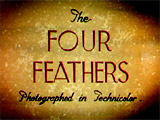



The Four Feathers (1939, UK), 130 minutes, D: Zoltan Korda
Director Zoltan Korda's classic adventure story and period piece, filmed in striking 3-strip Technicolor, was based upon Oliver H.P. Garrett's adaptation of A.E.W. Mason's 1901 adventure novel The Four Feathers. It was remade in 1955 as Storm Over the Nile, and as Shekhar Kapur's The Four Feathers (2002) starring Heath Ledger, Wes Bentley, and Kate Hudson. In the year 1898, young British army officer Harry Faversham (John Clements) was from a family with a strong military tradition due to his father General Burroughs (C. Aubrey Smith). Although a pacifist, Harry was serving as an officer in the Royal North Surrey Regiment. On the eve of his deployment one year after his father's death in 1885, he resigned his commission, disappointing his family, friends, and sweetheart fiancee Ethne Burroughs (June Duprez). He remained at home as a dangerous British military expedition/campaign left for Sudanese Egypt, to avenge the murder in Khartoum of General George Gordon. Disgracefully, he received four white feathers from three officers of his regiment: Capt. John Durrance (Ralph Richardson), Lt. Tom Willoughby (Jack Allen), and Lt. Peter Burroughs (Donald Gray), and one feather from his fiancee Ethne. The feathers were regarded as symbols of cowardice and shame. To redeem his name and prove his courage, he traveled to distant Egypt and ultimately to the Sudan disguised as a turban-wearing, mute, dark-red skinned native warrior (a Singli North African tribe member) marked with a brand on his forehead. There, he courageously fought for his country against the Mahdi worshipping dervishes and other Fuzzy Wuzzy nomadic tribesmen, warned of the advancing enemy, and fearlessly rescued all three of his army comrades in the Sudan: the blinded and defeated Durrance, and Willoughby and Burroughs in a prison camp. One by one, he surreptitiously returned the feathers to the presenters and returned vindicated for his brave efforts to defeat the enemy.





Gone With the Wind (1939), 220 minutes, D: Victor Fleming, George Cukor, and Sam Wood
David O. Selznick's majestic production with enduring appeal and technical achievements (three-strip Technicolor) was told through spectacle, romance, despair, conflict and travail. It was based upon Margaret Mitchell's great 1936 novel about the Civil War. It was one of the best films ever made - a landmark epic film and Best Picture winner. It recorded a phenomenal 13 Academy Award nominations and won eight competitive Oscars (with an Honorary Award and special recognition for William Cameron Menzies' production design and use of color). It featured a terrific, lyrical musical score by one of the greatest film composers of all time, Max Steiner. Its production costs were over $4 million - making it the longest and most expensive Hollywood sound film of the time. It also remains as the domestic box-office champ with a gross of $1.895 billion (adjusted for inflation). Many screenwriters and directors contributed to its success. It was a stunning, panoramic Civil War story of the transformed lives of leading families as the Southern aristocracy crumbled and the South was defeated. Its story was derived from the lives of a number of memorable characters, including pampered, spoiled, headstrong beautiful young Southern belle Scarlett O'Hara (Best Actress-winning Vivien Leigh) from the beloved Tara plantation, dashing and cavalier war profiteer and Charleston (SC) rogue Rhett Butler (Clark Gable), loyal black slave Mammy (Best Supporting Actress Oscar-winner Hattie McDaniel, the first given to an African-American), the ineffectual, soft-spoken character of Ashley Wilkes (Leslie Howard), and Ashley's saintly cousin Melanie Hamilton (Olivia de Havilland) whom he married.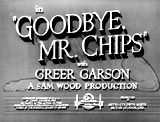


Goodbye, Mr. Chips (1939, UK), 114 minutes, D: Sam Wood
Director Sam Wood's sentimental romantic melodrama was based upon the 1934 James Hilton novel. It was remade by director Herbert Ross (in his directorial film debut) as an MGM musical - Goodbye, Mr. Chips (1969), starring Peter O'Toole. The tale (in flashback) was a portrait of caring, well-meaning, but shy and proper Latin schoolmaster Mr. Chipping ("Chips") (Best Actor-winning Robert Donat) at an English boys school, Brookfield School, in the late 1800s who devoted his life to his students. On a vacation, he found romance with outgoing and lively Katherine Ellis (Greer Garson in her American film debut), his future wife, and she transformed his life and ways of thinking. With her gentle and kind love and humanity, she was one of the few individuals who truly understood him, and helped him to overcome his shyness and rigidity. Although she tragically passed away during childbirth, her lessons endured and he became a dedicated teacher and popular institution at the school until his retirement and death in his eighties.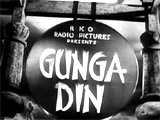



Gunga Din (1939), 117 minutes, D: George Stevens
RKO's classic, rousing action-adventure buddy film, set in 19th century colonial India, was filled with spectacle, action, and battle scenes, and comic touches as well. It was partly based on Rudyard Kipling's poem of the same name, and was derived from a script adapted by Charles MacArthur and Ben Hecht. One of the uncredited, contributing storywriters was novelist William Faulkner. In the story, three frontier veteran comrades-in-arms, British Sergeants in the Queen's Indian Regiment: Cutter (Cary Grant), MacChesney (Victor McLaglen) and Ballantine (Douglas Fairbanks, Jr.), were joined by a loyal native water carrier with soldierly ambitions Gunga Din (Sam Jaffe). The group put down an uprising and rebellion by a savage fanatical religious cult, the Thugs, devotees of the goddess Kali.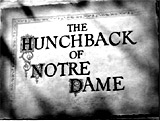



The Hunchback of Notre Dame (1939), 115 minutes, D: William Dieterle
Director William Dieterle's and RKO's film was the best screen adaptation of Victor Hugo's classic tale of a tragic love story, set in 15th century medieval Paris. It was filmed earlier as the silent film The Hunchback of Notre Dame (1923) with Lon Chaney, and later in 1956 with Anthony Quinn and Gina Lollobrigida. It was also a TV movie in 1982 with Anthony Hopkins and Lesley-Anne Down, and envisioned as a Disney animation in 1996. In the tale, a hideously-deformed, grotesque, outcast hunchback Quasimodo (Charles Laughton) lived as the bell-ringer in the towers of Notre Dame's Cathedral. The hunchback was scorned by an angry mob during a public whipping and pillory, but was shown pity and kindness by a beautiful Gypsy dancer girl, Esmeralda (Maureen O'Hara in her screen debut) who brought him water. He developed a tragic fondness for the girl, and rescued her from being hanged in the public square after being charged as a witch by bigoted, jealousy-crazed Chief Justice Frollo (Cedric Hardwicke). Quasimodo took her back into the bell tower where he claimed 'Sanctuary.'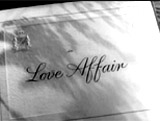




Love Affair (1939), 87 minutes, D: Leo McCarey
Director Leo McCarey's romantic comedy/soap opera ('weepie' tale) was remade years later (by the same director) with stars Cary Grant and Deborah Kerr in An Affair to Remember (1957). It was also remade as Love Affair (1994) starring real-life couple Warren Beatty and Annette Bening. It was not to be confused with Columbia's Love Affair (1932) with Humphrey Bogart. In the story, a traveling couple, playboy artist Michael Marnet (Charles Boyer) and nightclub singer Terry McKay (Irene Dunne), each engaged to others who were wealthier, met on board a transatlantic voyage and began a shipboard romance. They vowed to rendezvous again six months later on their return to the US atop the Empire State Building, to test their love. On the way to the meeting, Terry had an automobile accident and was reluctant to reveal her paralysis. She missed their meeting, and he assumed that she had been married in the meantime, although they were reunited again by chance at film's end.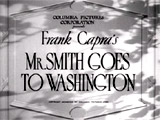


Mr. Smith Goes to Washington (1939), 129 minutes, D: Frank Capra
Columbia Pictures' and director Frank Capra's time-honored, enduring classic was a political comedy/drama about the populist triumph of the ordinary man (a familiar Horatio Alger story) over the corrupt political elite, to restore faith in democracy. Sidney Buchman based his script upon Lewis R. Foster's 1939 unpublished novel The Gentleman from Montana. It had many similarities to Capra's other idealistic political films, including Mr. Deeds Goes to Town (1936) and later Meet John Doe (1941). Idealistic, honest, wholesome and naive Boy Rangers' leader Jefferson Smith (James Stewart) was drafted to the Senate in Washington, DC by his state's governor Hubert "Happy" Hopper (Guy Kibbee). He was appointed as a freshman/junior Senator to complete the remaining term of dead US Senator Sam Foley. The corrupt "political machine," led by his state's senior Senator Joseph "Joe" Paine (Claude Rains) (a friend of Smith's late father), and mastermind corrupt political boss, Jim Taylor (Edward Arnold), believed Smith would easily be a controllable rubber-stamp. Upon Jefferson's arrival in Washington DC, the local hick and country bumpkin brought considerable amusement to reporters and Washington elites. One of Smith's first efforts was to propose a bill for a national boys' camp in his home state. However, he ran up against the pork-barrel, land-scam plans of a corrupt and greedy political machine that planned to support an appropriations bill to fund a dam-building graft scheme for the same site. Smith became stubbornly determined to not forsake his dreams and to do what's right, while Boss Taylor urged Sen. Paine from Smith's own state to discredit Smith's opposing bill by falsifying documents and arguing that the camp was also a pork-barrel effort. With the support of his cynical secretary Clarissa Saunders (Jean Arthur), Smith opposed his powerful political adversaries. The climax of his heroic efforts was a rousing, exhausting and passionate, one-man 23 hour-filibuster on the Senate floor to postpone the appropriations bill. In a dramatic conclusion in the film's final climactic moments, the remorseful Senator Paine (who threatened suicide) admitted his complicity to derail Smith's efforts, and completely exonerated him.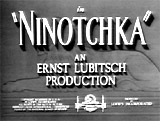


Ninotchka (1939), 110 minutes, D: Ernst Lubitsch
This very enjoyable romantic comedy was directed with a light touch and sophistication by Ernst Lubitsch, and was most known for being advertised as the film in which "Garbo Laughs." It featured a great script by Billy Wilder and Charles Brackett, and was remade the next year as Comrade X (1940), featuring Hedy Lamarr and Clark Gable, and later as Iron Petticoat (1956) starring Katharine Hepburn and Bob Hope. In the film's plot, stern, austere, icy-cold Soviet commissar Lena Yakushova "Ninotchka" (cool and beautiful Greta Garbo in her first major comedy) was sent to Paris to check up on and chastise three over-indulgent fellow comrades: Michael Iranoff (Sig Ruman), Buljanoff (Felix Bressart), and Kopalski (Alexander Granach). The trio had easily been seduced by Western capitalism in Paris, and failed to negotiate the sale of former Russian Grand Duchess Swana's (Ina Claire) imperial jewels, in exchange for tractors. "Ninotchka" was met by suave, Parisian playboy Count Leon D'Algout (Melvyn Douglas), the Duchess' lover, who eventually seduced and charmed the rigid, no-nonsense Russian, and she fell victim to the same traps - capitalism and romance in the City of Light.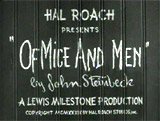

Of Mice and Men (1939), 107 minutes, D: Lewis Milestone
This excellent low-budget film adaptation of John Steinbeck's Depression-era classic 1937 novella was a bittersweet, sensitive, powerful but tragic story of two ranch hands-drifters traveling together in California's Salinas Valley. It was remade faithfully as director Gary Sinise's Of Mice and Men (1992) with John Malkovich and Gary Sinise starring. In the rural drama, two migrant field workers were introduced: Lennie Small (Lon Chaney, Jr.) - a large, physically-strong but dim-witted (retarded and potentially dangerous) individual, and itinerant farm-worker George Milton (Burgess Meredith), Lennie's cousin (and loyal guardian-protector). Brain-damaged Lennie (who had been kicked in the head by a horse) had a great passion for petting soft furry things (mice, puppies, birds, girls' hair or soft fabric, etc.) and was hopeful that he could tend rabbits some day: ("Tell me about the rabbits, George"). [Note: In the film's opening, Lennie was stroking a dead bird in his pocket. In the novel, the dead creature in Lennie's pocket was a mouse - more significant and the reason for the film's title.] George often fantasized with Lennie about how they would someday end their drifting and nomadic lifestyle, and live peacefully on their own small ranch with farm animals. But Lennie's innocence, feeble-mindedness, his clumsy misuse of his physical strength, and finally a brutal set of circumstances usually ended their comforting dream. They were employed at a ranch near Soledad, CA owned by ranch boss Jackson (Oscar O'Shea), who was assisted by harsh and crusty Whit (Noah Beery Jr.), ranch foreman Slim (Charles Bickford), and Jackson's cruel, pugnacious, arrogant and bullying foreman son Curley Jackson (veteran B-class cowboy star Bob Steele) - a former boxer. Curley's flirtatious, provocative, newly-married but already bored wife was Mae Jackson (Betty Field), often called a "tramp" and "jail bait" by the obsessively-jealous Curley. In the film's tragic conclusion after Curley had thrown his promiscuous wife out, the brutish Lennie - already saddened by the loss of his puppy that he had unintentionally killed, was confronted by Mae in the ranch's barn. She was hiding from Curley and was planning her getaway after dark. She told Lennie her dream plan about fleeing to Hollywood to become a movie star, while he told her about his dream of living on a farm. When Lennie shared his love of petting soft things, he was encouraged to stroke Mae's hair, but ended up accidentally breaking her neck (and/or suffocating her) when she panicked and screamed. Behind the bars of a barn stall, he tried to stifle her resistance to end his strokes that had become too rough, by covering her mouth to keep her quiet, but she ended up dead. As a vigilante lynch mob formed, Lennie fled to the thicket by a bend in the Salinas river after remembering George's instructions about where to hide and escape if they encountered trouble. George sensed where Lennie might be hiding, grabbed a pistol, and approached his child-like brute friend Lennie. To distract him, he instructed Lennie to look across the river and imagine their dream farm, as he retold him their fanciful story. Then, he placed a pistol up to Lennie's head and pulled the trigger. Lennie's last words were: "Yeah, I can see it. Right over there. George, I can see it." It was left unclear and ambiguous whether George would be charged with Lennie's mercy-killing.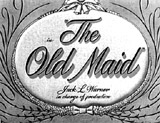

The Old Maid (1939), 95 minutes, D: Edmund Goulding
Director Edmund Goulding's family-based, melodramatic mother-daughter tear-jerker was set during the Civil War period (and after), adapted from Edith Wharton's 1924 novella, and Zoë Akins' 1935 Pulitzer Prize-winning play, with a magnificent Max Steiner score. In the film's opening set in the early 1860s in Philadelphia, PA, Delia Lovell Ralston (Miriam Hopkins) spurned cad, ex-fiancee, and impulsive playboyish suitor Clem Spender (George Brent) who had returned after a two year, heavy-drinking absence in Paris. Instead, she proceeded to marry socially-respectable but stuffy munitions manufacturer James "Jim" Ralston (James Stephenson). Delia's worried wall-flower cousin Charlotte Lovell (Bette Davis), who had always liked Clem and served as a bridesmaid at Delia's wedding, commiserated and slept (off-screen) that evening with Delia's rejected, hot-headed and ex-beau when she spent a late night with him - and became pregnant. Soon after on the next day, Lt. Clem Spender departed from the train station (after leaving a tearful Charlotte) to fight as a Union soldier in the Civil War, and he died on the battlefield at the Battle of Vicksburg in 1863. Meanwhile, Charlotte secretly became an unmarried mother, and journeyed West to have her baby. About 4 years later in 1866 in Philadelphia, Delia was now the mother of two children with James. Charlotte returned and refurbished the family's home stables as the Charlotte Lovell Nursery for War Orphans - a day orphanage for over 20 children of working mothers; there, she could secretly hide her dreadful and scandalous secret and care for her illegitimate daughter - love child and "foundling" Clementina "Tina" (Marlene Burnett as young child) (named after Clem!). On the day of Charlotte's wedding in June of 1866 to be held at the Ralston mansion, she was about to marry Joseph "Joe" Ralston (Jerome Cowan), Jim's brother (Delia's husband). She became concerned about giving up her nursery to be dutiful and obey her future husband, so she decided to confess to Delia the existence of her love child in the nursery. Delia was worried that Charlotte's fiancee would not accept the news of an illegitimate child. Charlotte also admitted her sinful decision to sleep with Clem - a man she had loved since childhood. The conniving and selfish-minded Delia spitefully set about to derail Charlotte's wedding to her fiancee Joe, by divulging Charlotte's secret for the sake of the Ralston's reputation. Hoever, instead of revealing the real reason, Delia stressed the common rumor that Charlotte was "sick" and "unhealthy" after a trip West five years earlier, when she had contracted "lung trouble." Joe called off the marriage without ever knowing about Charlotte's illegitimate child. With her marital plans ruined, Charlotte retreated into seclusion ("shut...away from the world"), reappearing only six months later when a letter informed her about Jim's (Delia's husband) serious horse-riding accident, that led to his death. Charlotte (with Tina) accepted the widowed Delia's awkward living arrangement invitation - to move into the large Ralston mansion. Delia would take care of 'Tina' - acting as her mother, while Charlotte was to be regarded as Aunt Charlotte for her unknowing, patronizing niece. Fifteen years later (signaled by a montage), Aunt Charlotte appeared - now with wisps of gray hair, and acting like a serious, bitter, sullen, stern-faced, spinster-like 'old maid.' Her daughter - free-spirited teenaged Tina (Jane Bryan as young adult) was romantically interested in her handsome young boyfriend Lanning Halsey (William Lundigan) from a prominent family. Tina often delivered disrespectful words to Delia (her "Mommy") about how Aunt Charlotte was critical, cruel, old-fashioned, and unfair - and a 'ridiculous, narrow-minded old maid.' The fact that Tina had "no position, no name" because she was a "foundling" caused Delia to be allowed by Charlotte to legally adopt Tina to provide her with legitimate social status, so that she would be "desirable" as a marital partner with Lanning. On the eve of Tina's wedding day in June 1881, on the stairs with Delia, Charlotte threatened to divulge the truth of Tina's identity and parentage to her. However, she turned conciliatory and kind in a very tearjerking sequence in Tina's bedroom - she couldn't bring herself to destroy her daughter's happiness. And then in a rapprochement scene with Delia, Charlotte accepted the fact that both Clem and Tina loved Delia more than they did her. To assuage Charlotte, Delia informed Tina that Charlotte, her old maid aunt, had sacrificed her own happiness by refusing to marry a man who did not want to raise Tina as his own. And then she made a very special request of Tina - before leaving on her honeymoon, she must save her very last kiss for Charlotte. The final scene was of the new bride's last kiss given to her special Aunt - fulfilling the special request of Delia - never knowing that Charlotte was her real mother. The very satisfied Charlotte caressed the cheek that Tina had just lovingly kissed.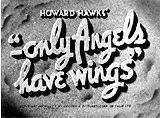


Only Angels Have Wings (1939), 121 minutes, D: Howard Hawks
Director Howard Hawks' classic adventure film and dramatic character study featured a great cast and sharp script-writing. Its main plot was about daring cargo pilots who hazardously flew air freight and mail over the rugged and dangerous Andes Mountains for the small Barranca Airways company in South America. In the film's opening, Brooklyn showgirl and cabaret singer Bonnie Lee (Jean Arthur) became stranded in the small "banana republic" of Barranca. A flying service in the area was owned by "Dutchy" (Sig Rumann), consisting of a hotel, flight HQs, and saloon. The aviators were managed and led by chief pilot Geoff Carter (Cary Grant). Their imminent main goal was to receive a government contract after six months of regular service, to provide mail delivery in the area. Tensions were set on edge when Bonnie entered Dutchy's saloon/hotel and met Trans-Andes air courier director Carter - and as the two sparred with each other, they also developed an affection for each other. One of the pilots Joe Souther (Noah Beery, Jr.) took off with a mail delivery, but had to return to the airport due to foggy conditions. In his hurried attempt to land, he died in a fatal crash, and Bonnie was taken aback by Carter's no-nonsense, stoic reaction to Joe's death. Further complications arose when pilot-flier Bat McPherson (silent film star Richard Barthelmess in a comeback role, although it was his last) arrived and was accompanied by his sexy wife Judy (Rita Hayworth). Both had histories that were intertwined - McPherson still felt shunned and guilt-ridden by a fatal accidental crash years earlier. He believed he was responsible for the death of flier Kid Dabb's (Thomas Mitchell) brother, for jumping out of a plane and leaving his co-pilot/mechanic to die, and therefore now felt that he had to prove himself. Judy was embittered Carter's ex-girlfriend, who made further attempts to seduce him, while Bonnie seemed far more-suited for Carter's temperament. [Note: Cary Grant never said, "Judy, Judy, Judy" to co-star Rita Hayworth in this film.] Carter's close flier-friend - the near-blind, aging Kid Dabb was told that he could no longer pilot a plane due to his diminished eyesight. Carter was forced to hire McPherson to fly a dangerous mission into the mountains, and afterwards made him a permanent member of the flying-team when he displayed courage and skill. As the film was coming to its conclusion, and with no other pilots available, Carter was forced to send McPherson through the dangerous fog-shrouded Andes mountain pass, with Kid Dabb volunteering to be his co-pilot on the risky mission. The doomed flight collided with a flock of giant condors, smashed the windshield, damaged the engine, lethally injured Dabb, and the plane caught on fire. After a successful emergency landing executed by McPherson back at the base, Kid Dabb died with Carter sorrowfully there to comfort him. In the final scene, Carter and flier Les Peters (Allyn Joslyn) decided to retry the flight through the pass, now that the fog had lifted, and it was hinted that Bonnie (who had proven herself faithful and worthy) would be waiting for Carter on his return.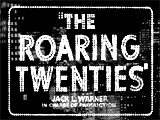

The Roaring Twenties (1939), 104 minutes, D: Raoul Walsh
Director Raoul Walsh's brisk, semi-documentary styled action and dramatic crime-gangster film adaptation (his debut film with Warner Bros - the tough-guy studio of the 1930s) was derived from journalist Mark Hellinger's realistic story about 1920s gangsterism and the Prohibition days in New York. Memorably, this film marked the third and final screen pairing of Humphrey Bogart and James Cagney - two quintessential gangster characters. It told a fatalistic story, spanning the years from 1919 to 1933 (the End of Prohibition), about the rise and fall of a rough gangster who was bound to die a self-sacrificial, bloody death. Three WWI American doughboys (who had become buddies in the trenches) returned from the battlefields after the Armistice: Eddie Bartlett (James Cagney), Lloyd Hart (Jeffrey Lynn) and George Hally (Humphrey Bogart). Eddie, one of the returning veterans, a former taxicab-garage mechanic, couldn't find work as he had expected, and was forced to become a cab driver - delivering packages. After meeting Eddie, matronly New York speakeasy gal (nightclub hostess) Panama Smith (Gladys George) (based upon Texas Guinan) suggested Eddie turn to the lucrative business of racketeering and bootlegging (due to the just enacted Prohibition Act). Eddie eased into his new career by first delivering the contraband in his own taxicab, and then became a better-dressed, full-time entrepreneur as he cashed in on the illegal profits and manufactured his own illegal bathtub gin. Eddie's profits led him to build a fleet of cabs (The Red & Blue Cab Co.) for his bootlegged liquor deliveries. He soon flourished in the illicit business in a partnership with war buddy friend-lawyer Lloyd Hart and then with gangster/saloon business-keeper and bootlegger George Hally. Soon, gang warfare and violence between rivals increased when a new weapon was showcased - the 'tommy-gun'. During a robbery by Eddie's gang of a quarter of a million dollars worth of liquor in a shipment (belonging to fellow bootlegger Nick Brown) that had been confiscated by the government and stored in a guarded US government warehouse in NYC, George Halley unnecessarily and cold-bloodedly shot one of the security guards. After learning of the murder, Eddie's crusading lawyer Lloyd decided to break ties with Eddie, and Eddie was also ultimately forced to end his association with his corrupt, double-crossing associate George Hally. Eddie's fortunes were wiped out with the 1929 Stock Market crash, and now financially-ruined, he was forced to sell all but one taxi-cab in his company back to George for $250,000 to recoup all of his debts. Now that Eddie's life was reduced back to what he had done years earlier, driving a cab, he often reminisced with Panama about the old days, and began to drink heavily. In the meantime, Lloyd had married Eddie's ex-girlfriend and love interest Jean Sherman (Priscilla Lane), while Hally had become a ruthless and murderous crime boss, and found himself under attack by crusading prosecutor DA Hart. Eddie attempted to spare the lives of Jean (Eddie was still in love with her) and her husband, whose life had been threatened by sinister kingpin mobster Hally. In the film's extremely memorable final scene, a violent confrontation occurred between the two gangsters in Hally's fancy upstairs bedroom on New Years' Eve when Eddie attempted to save Hart and Jean. When Hally refused to cooperate, he was shot dead by Eddie, but then Eddie was also lethally wounded by one of George's gunmen as he fled. The mortally-wounded Eddie staggered to the nearby Community Church. In his memorable, self-sacrificial, redemptive death scene, he stumbled, climbed, wobbled, and then tumbled down the church's flight of snow-covered steps. A weeping Panama Smith ran to him and cradled his head in her arms as he expired on the steps of the church, and provided his poignant epitaph to a policeman: "He used to be a big shot."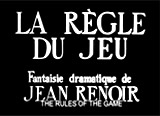


The Rules of the Game (1939, Fr.), (aka La Règle du Jeu), 110 minutes, D: Jean Renoir
Director Jean Renoir's brilliant social comedy was originally banned as too "demoralizing." It was a satirical observation of amoral bourgeois life and the social class system as a dark upstairs-downstairs bedroom farce (of musical beds). It was mostly set at the start of WWII at La Colinière - the French chateau of aristocratic Robert, Marquis de la Chesnaye (Marcel Dalio) and his upper-class heiress wife Christine, Marquise de la Chesnaye (Nora Gregor), an Austrian-French noblewoman. (Meanwhile, Robert also maintained a mistress named Geneviève de Marras (Mila Parély), but would soon be ending their affair). A lavish party during a weekend retreat was being held in the chateau, where a darkly disturbing "Dance Macabre" (unusual after-dinner entertainment) was performed by the servants of the house, dressed as skeletal figures with umbrellas. It was a grotesque dance of death for the rich audience, eerily foreshadowing the cold murder of lovelorn, philandering pilot André Jurieux (Roland Totaine) who was in love with Christine (who were plotting to run away together). The film's most famous scene was the shooting party, including the graphic slaughter of pheasants and rabbits, with the disturbing shot of a rabbit in the last throes of dying, clutching its fore-paws to its breast. Christine - with growing doubts about Andre - also admitted that she loved her close friend - the clownish, middle-aged, wise but low-brow Mr. Octave (director Jean Renoir) in a greenhouse. There, they kissed each other passionately and hopelessly, but he mournfully knew that their love affair was an impossibility. There, Andre was shot dead in a case of mistaken identity, when he later wore Octave's overcoat as he approached Christine in the greenhouse, and was killed by jealous Edouard Schumacher (Gaston Modot) - Robert's gamekeeper. Schumacher wrongly believed that Octave was trying to run off with his wife Lisette (Paulette Dubost), Christine's maid. Afterwards, the murder would probably be ruled as an accident.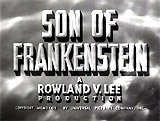

Son of Frankenstein (1939), 99 minutes, D: Rowland V. Lee
This well-made, atmospheric, and eerie horror film was the third film in the 'Frankenstein' series - the second sequel to the original Frankenstein (1931) film, and the follow-up film to Bride of Frankenstein (1935). Now that it was 25 years since the 'death' of the Monster, Dr. Henry Frankenstein's son Baron Wolf von Frankenstein (Basil Rathbone) returned to his ancestral castle inhabited by the creepy demented blacksmith Ygor (Bela Lugosi) - a shepherd with a crooked, broken neck who had survived a hanging for grave-robbing. Frankenstein was encouraged to revive his experiments on the Monster to restore the Frankenstein name, but the results were disastrous. Ygor vengefully set the Monster on a killing course in the countryside, to seek justice against the jurors who had ruled in his graverobbing criminal case. In the ending, to save his young son Peter (Donnie Dunagan), the Baron pushed the Monster into a molten sulphur pit under his laboratory.

Stagecoach (1939), 96 minutes, D: John Ford
John Ford's classic western was filmed in the majestic Monument Valley of the Southwest. Dudley Nichols' screenplay was based on Ernest Haycox's 1937 short story "Stage to Lordsburg." It has been considered a landmark quintessential film, elevating cheap "B" westerns beyond 'singing cowboy' tales or serials (such as the Lone Ranger) and other western action heroes to a more serious genre. A diverse group of eight passengers traveling on a stagecoach together from Tonto to Lordsburg through dangerous and hostile Apache Indian land were each representative character types. They included a saloon dance-hall girl - a shunned Tonto prostitute Dallas (Claire Trevor), a drunken Dr. Josiah Boone (Academy Award-winning Best Supporting Actor Thomas Mitchell), a pregnant about-to-give birth Mrs. Lucy Mallory (Louise Platt) on her way to meet her Cavalry lieutenant husband, a shady Southern card-sharp gambler Hatfield (John Carradine), a timid whiskey salesman Samuel Peacock (Donald Meek), and a pompous banker Henry Gatewood (Berton Churchill) with a mysterious satchel (containing embezzled funds) who was accompanied by his wife (Brenda Fowler). Along the way, the stage driver Buck Rickabaugh (Andy Devine) and his "shotgun" assistant Marshal Curley Wilcox (George Bancroft) stopped to arrest escaped prisoner outlaw, the Ringo Kid (John Wayne in his first major role, the role that made him commercially famous), who was seeking revenge for the deaths of his brother and father, against three men (members of the Plummer gang) in Lordsburg. As The Kid was being taken back to jail as a prisoner by the Marshal, in the face of a savage Indian attack, he defended the passengers' safety with his heroic self-sacrifice and courage. The film was noted for the exciting chase of Apaches after the stagecoach hurtling across the plains, with tremendous stuntwork by Yakima Canutt. The group mostly survived when rescued by a cavalry charge, although Hatfield died from a gunshot. In Lordsburg, Gatewood was arrested for absconding bank funds, and Peacock was treated for an arrow wound. As it turned out, the social outcasts or misfits in the group were the most honorable people, while the supposedly 'respectable' individuals proved to be the most despicable and ignoble. During a final showdown sequence, the Ringo Kid engaged in a successful shootout with the Plummers, and then left with Dallas headed toward his ranch in Mexico.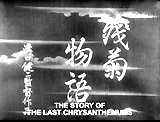


The Story of the Last Chrysanthemum(s) (1939, Jp.) (aka Zangiku Monogatari), 148 minutes, D: Kenji Mizoguchi
Set in 1888 Tokyo, this was a beautiful, melodramatically-told, moving, sentimental, humanistic film (with lengthy camera takes and long-shots). It told about a tragic, ill-fated romance due to rigid class-based discrimination, social disparities and inequities. Although openly praised, famous Kabuki actor Kikugoro Onoe V's (Gonjurô Kawarazaki) adoptive son Kikunosuke Onoue (Shôtarô Hanayagi), who was less disciplined, talented and skilled (and lived a playboyish life with geishas), suspected that he was being falsely lauded and flattered due to his father's reputation, as others hypocritically talked behind his back. Otoku (Kakuko Mori), the nurse/servant of his adoptive father's newborn infant male child, honestly critiqued and assessed his acting - but was thereafter fired for openly fraternizing with him (and for perceived gossiping). Frustrated and forbidden to see her after her banishment and dismissal by his authoritarian father, he left his comfortable and privileged life and home in Tokyo, located her outside the city in the faraway city of Osaka, and stubbornly married her (against his father's demands). The wayward son was determined and persevering to apply himself to his craft and become a great actor on his own merits. Without the solid legacy of his acting father to fall back upon however, a life of poverty, perpetual hardship and misfortune, immense challenges, and obscurity seemed to engulf the young couple. He only found work as an itinerant actor performing for small lower-class audiences. However, after a lucky break, he succeeded in a Kabuki role, and decided to return to Tokyo (but without Otoku since she would be rejected again by his family), to join a Kabuki troupe there. A year later after his family had accepted his marriage and he was a semi-successful actor, Kikunosuke returned to Osaka during a performance tour and found Otoku dying of consumption. Always supportive and believing in him, Otoku remained selfless and encouraging, but soon passed away all alone, while he bowed and accepted accolades from the now-supportive public.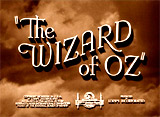




The Wizard of Oz (1939), 103 minutes, D: Victor Fleming
Director Victor Fleming's colorful (Technicolored) children's fantasy classic became one of the most popular films of all time - and everyone's cherished favorite movie. The perennial fantasy musical from MGM during its golden years, based on Frank Baum's 1900 novel, was screened perennially for many seasons on television. Its many songs in its Oscar-winning Best Original Score were from Harold Arlen (composer) and Edgar "Yip" Harburg (lyricist). All of its fanciful images (the Yellow Brick Road, the Kansas twister), characters (e.g., Auntie Em, Toto, Dorothy, the Wicked Witch, Scarecrow, Tin Man, Cowardly Lion, the Wizard), dialogue (e.g., "Lions and tigers and bears, oh my!", "We're not in Kansas anymore," "Follow the Yellow Brick Road," or the film's final line: "There's no place like home"), and theme song music (Best Original Song: "(Somewhere) Over the Rainbow") have become indelibly remembered. In the main plot, Kansas farm girl Dorothy Hale (Judy Garland in a star-making performance) (Kansas sequences were in sepia-tone) dreamt of a better place, ran away, and was transported with her beloved dog Toto in a twister "beyond the rainbow" to the magical fantasy land of Oz (Oz sequences were in Technicolor). There she met delightfully colorful characters including the Wicked Witch of the West (Margaret Hamilton, also the nasty Miss Gulch in the Kansas scenes), and was dubbed the hero of Munchkin Land for vanquishing her. She was joined by three companions (all Kansas farmhands) - the Scarecrow/Hunk (Ray Bolger), the Tin Man/Hickory (Jack Haley), and the Cowardly Lion/Zeke (Bert Lahr), and watched over by good witch Glinda (Billie Burke). With her companions, she set off on the yellow brick road to seek help from the Wizard (Frank Morgan, also a phony fortune teller in Kansas) in order to get home, and to grant their wishes. The Wizard taught them that all of their desires were already within their grasp, after they subdued the Witch. In the land of Oz after facing many challenges and defeating the Wicked Witch, Dorothy awakened and discovered that things weren't always better somewhere else ("There's no place like home") - she found herself in her bedroom home, back from her fantastical dream/hallucination.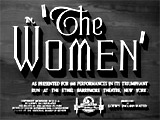


The Women (1939), 132 minutes, D: George Cukor
Director George Cukor's and MGM's satirical comedy-drama featured an all-female and all-star cast of more than 125 strong-minded and gossipy high-society Manhattan women, based upon Clare Boothe's (Luce) 1936 play. It was full of biting and snappy wit, fast dialogue, and superb performances from a great cast of memorable characters. The cast of women often engaged in cat-fighting and bitching, vicious gossip and cattiness, husband-stealing, and back-stabbing, while the film provided insight into female bonding and the role of women in society. The complex story line about matrimony and the struggles between men and women was full of twists and diversions, almost unimportant. One of the happily-married, contented socialite women Mary Haines (Norma Shearer) learned that her husband Stephen was having an affair with amoral, predatory perfume sales counter-clerk Chrystal Allen (Joan Crawford), a conniving gold-digger. One of her catty friends, Mary's cousin Sylvia Fowler (Rosalind Russell), learned of the alleged affair after hearing about it at an elite salon during a visit to her manicurist. Mary sought a quickie divorce with a six-week stay in Reno at a ranch, where she encountered others there for the same reason: elderly Countess de Lave (Mary Boland), scrappy chorus girl Miriam Aarons (Paulette Goddard) (who was having an affair with Sylvia Fowler's husband), and young shy (and pregnant) friend Peggy Day (Joan Fontaine). After Mary's divorce was finalized, she learned that her husband Stephen had married Chrystal. Ultimately a few years later, through her daughter Little Mary (Virginia Weidler), Mary learned that her ex-husband wasn't fond of Chrystal, who had taken another lover - the married singing cowboy and radio star Buck Winston, who had married the Countess. In the end, Mary successfully plotted to get Stephen back and stole him away from Chrystal. Mary gloated: "I've had two years to grow claws mother. Jungle red," while Chrystal was resigned to her downfall - but was able to deliver the final ultimate insult line to the other women: "And by the way, there's a name for you ladies, but it isn't used in high society—outside of a kennel. So long, ladies!"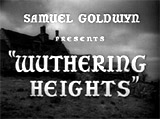




Wuthering Heights (1939), 104 minutes, D: William Wyler
Director William Wyler's superb romantic love story (with beautiful Oscar-winning black and white cinematography by Gregg Toland) was derived from Emily Bronte's tragic 1847 Victorian novel, about a pair of eternal lovers. In the opening of the period drama in the mid-19th century on the Yorkshire moors in England, a new neighbor named Lockwood caught in a fierce snowstorm was taken in the estate of Wuthering Heights by its host Heathcliff (Laurence Olivier). In the upstairs bedroom, Lockwood was startled by an icy hand and a strange, ghostly female voice, desperately crying: "Heathcliff." Distressed by what was reported to him, Heathcliff ran off into the night to search for Cathy's ghostly spirit. His housekeeper Ellen Dean (Flora Robson) then described, in flashback, Heathcliff's life story to Lockwood from 40 years earlier. As an abandoned orphan, Gypsy boy Heathcliff (Rex Downing as child) was taken in by a well-to-do early 19th century English family on the isolated moors, run by widower Mr. Earnshaw (Cecil Kellaway). Heathcliff became their stable boy and fell in love with the family's spoiled young daughter Catherine Earnshaw (Sarita Wooten as child, Merle Oberon as adult), his childhood friend, although her brother Hindley (Hugh Williams) was contemptuous of him as an outcast. The beautiful manor-born Cathy was desperately in love with Heathcliff (they were playmates together, and obviously soul-mates), and often fantasized at Peniston Crag that they were king and queen of their make-believe castle. Because of his lowly birth, however, she also began to socialize with a wealthy neighbor Judge Linton's (Cecil Humphreys) son, young Edgar Linton (David Niven as adult). When Mr. Earnshaw died, Hindley took over and became a dissolute gambler, and mistreated Heathcliff. During a jealous misunderstanding (when Heathcliff missed hearing Cathy tell Ellen that she truly loved him and had said: "I am Heathcliff!"), Heathcliff stormed off. Later a few years later, he returned with driving ambition, sophistication and distinction, and moderate wealth, and discovered that Cathy had married the rich Edgar Linton, in spite of her passionate love for him. In revenge, he bought Wuthering Heights from Hindley (by buying off his drinking and gambling debts), and spitefully married Edgar's naive sister Isabella (Geraldine Fitzgerald) - but then neglected her. The long-suppressed passionate feelings that Heathcliff and Cathy had for each other continued to torment them and embitter them as haunted, star-crossed lovers. They pledged to be together for eternity as the ailing and sick Cathy died in his arms at a window as they looked upon the moors. Heathcliff continued to mourn her passing. At the end of Ellen's flashbacked story, the local Dr. Kenneth (Donald Crisp) entered and reported that he had just seen Heathcliff on the moors with a woman. He approached and located Heathcliff's dead body. The film concluded with the ghostly spirits of the two ascending Peniston Crag in the snow.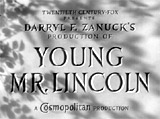

Young Mr. Lincoln (1939), 100 minutes, D: John Ford
Director John Ford's remarkably realistic period piece and historical drama was based upon Lamar Trotti's original story. It was a recreation and character study of the early years of Abraham Lincoln (Henry Fonda), the 16th President of the US, beginning around the time of the Whig convention of 1832. A rough-hewn, shy, Kentucky log cabin-born young Abe experienced the loss of his first love Ann Rutledge (Pauline Moore), and then struggled to make it as a country backwoods lawyer. The new state capital of Springfield, Illinois was also the location of the new law office of the prominent young lawyer, who was also recently elected to the state's legislature after a successful campaign. His folktale attributes were emphasized at day-long Independence Day celebrations: with log-splitting, and pie-eating judging, etc. During a tug-of-war contest, Scrub White (Fred Kohler, Jr.) and John Palmer Cass (Ward Bond) pestered young Sarah Clay (Arleen Whelan). To defend her, her husband Matt Clay (Richard Cromwell) and her brother-in-law Adam Clay (Eddie Quillan) intervened to stop Cass and White. But later that night, drunken bully White confronted the two brothers Matt and Adam. During their brawl, White drew his gun and it fired. Cass appeared from the darkness, and claimed White was dead on the ground - not from a single gunshot, but from a knife that Cass had pulled from his heart. Cass claimed that he saw the killing committed by the Clay brothers in the "moon-bright" light. Lincoln became involved in the defense of the two farmers accused of murder. Mrs. Abigail Clay (Alice Brady) saw the struggle, but wouldn't talk about it, even when her two boys were arrested for manslaughter. Both were determined to take the blame, trying to spare each other from hanging. Lincoln was able to convince an angry lynch mob to disperse from the jail. He argued that he needed this first case as an up-and-coming lawyer. During the trial, the case was prosecuted by John Felder (Donald Meek). Lincoln argued that the defendants acted in self-defense when they saw White with a gun. Cass ultimately testified that he saw Matt kill Scrub White by stabbing - at nighttime in the moonlight when he was about 100 yards away. As Cass was leaving the witness stand area, Lincoln asked Cass what he had against Scrub White. Lincoln produced a Farmer's Almanac, proving on page 12 that Cass' story was a lie. The almanac stated that the moon had set 40 minutes before White was killed, making it pitch-black at the time of the murder. Lincoln coerced a confession from Cass that he had lied - Cass admitted that he had killed White with Matt's dropped knife (when he came upon the scene and saw that White was unhurt): "I didn't mean to kill him!" Cass was trying to frame one of the Clays for the murder. Matt and Adam were released from jail as a result of Lincoln's smart defense. In the film's famous ending, Lincoln slowly climbed a distant hill as a silhouetted figure - a symbolic ascent or rise.